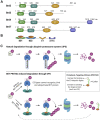Role of BET Proteins in Inflammation and CNS Diseases
- PMID: 34604312
- PMCID: PMC8481655
- DOI: 10.3389/fmolb.2021.748449
Role of BET Proteins in Inflammation and CNS Diseases
Abstract
Bromodomain and extra-terminal domain (BET) proteins consist of four mammalian members (BRD2, BRD3, BRD4, and BRDT), which play a pivotal role in the transcriptional regulation of the inflammatory response. Dysregulated inflammation is a key pathological process in various CNS disorders through multiple mechanisms, including NF-κB and Nrf2 pathways, two well-known master regulators of inflammation. A better mechanistic understanding of the BET proteins' role in regulating the inflammatory process is of great significance since it could reveal novel therapeutic targets to reduce neuroinflammation associated with many CNS diseases. In this minireview, we first outline the structural features of BET proteins and summarize genetic and pharmacological approaches for BET inhibition, including novel strategies using proteolysis-targeting chimeras (PROTACs). We emphasize in vitro and in vivo evidence of the interplay between BET proteins and NF-κB and Nrf2 signaling pathways. Finally, we summarize recent studies showing that BET proteins are essential regulators of inflammation and neuropathology in various CNS diseases.
Keywords: Alzheimer’s disease; multiple sclerosis; neuroinflammation; neurological diseases; proteolysis-targeting chimera; seizure; spinal cord injury; stroke.
Copyright © 2021 Liu, Yang and Candelario-Jalil.
Conflict of interest statement
The authors declare that the research was conducted in the absence of any commercial or financial relationships that could be construed as a potential conflict of interest.
Figures

Similar articles
-
Bromodomain and extra-terminal domain bromodomain inhibition prevents synovial inflammation via blocking IκB kinase-dependent NF-κB activation in rheumatoid fibroblast-like synoviocytes.Rheumatology (Oxford). 2016 Jan;55(1):173-84. doi: 10.1093/rheumatology/kev312. Epub 2015 Aug 31. Rheumatology (Oxford). 2016. PMID: 26324948
-
Bromodomain and extraterminal domain-containing protein inhibition attenuates acute inflammation after spinal cord injury.Exp Neurol. 2018 Nov;309:181-192. doi: 10.1016/j.expneurol.2018.08.005. Epub 2018 Aug 19. Exp Neurol. 2018. PMID: 30134146
-
Selective degradation of BET proteins with dBET1, a proteolysis-targeting chimera, potently reduces pro-inflammatory responses in lipopolysaccharide-activated microglia.Biochem Biophys Res Commun. 2018 Feb 26;497(1):410-415. doi: 10.1016/j.bbrc.2018.02.096. Epub 2018 Feb 12. Biochem Biophys Res Commun. 2018. PMID: 29448097
-
Bromodomain and Extra-Terminal Proteins in Brain Physiology and Pathology: BET-ing on Epigenetic Regulation.Biomedicines. 2023 Mar 1;11(3):750. doi: 10.3390/biomedicines11030750. Biomedicines. 2023. PMID: 36979729 Free PMC article. Review.
-
The Functions of BET Proteins in Gene Transcription of Biology and Diseases.Front Mol Biosci. 2021 Sep 3;8:728777. doi: 10.3389/fmolb.2021.728777. eCollection 2021. Front Mol Biosci. 2021. PMID: 34540900 Free PMC article. Review.
Cited by
-
Advancements in PROTAC-based therapies for neurodegenerative diseases.Future Med Chem. 2025 Mar;17(5):591-605. doi: 10.1080/17568919.2025.2463310. Epub 2025 Feb 11. Future Med Chem. 2025. PMID: 39931801 Review.
-
Targeting bromodomain-containing proteins: research advances of drug discovery.Mol Biomed. 2023 May 5;4(1):13. doi: 10.1186/s43556-023-00127-1. Mol Biomed. 2023. PMID: 37142850 Free PMC article. Review.
-
Targeted BRD4 protein degradation by dBET1 ameliorates acute ischemic brain injury and improves functional outcomes associated with reduced neuroinflammation and oxidative stress and preservation of blood-brain barrier integrity.J Neuroinflammation. 2022 Jun 27;19(1):168. doi: 10.1186/s12974-022-02533-8. J Neuroinflammation. 2022. PMID: 35761277 Free PMC article.
-
Identification of Parkinson's disease-associated chromatin regulators.Sci Rep. 2023 Feb 22;13(1):3084. doi: 10.1038/s41598-023-30236-4. Sci Rep. 2023. PMID: 36813848 Free PMC article.
-
The BET PROTAC inhibitor dBET6 protects against retinal degeneration and inhibits the cGAS-STING in response to light damage.J Neuroinflammation. 2023 May 22;20(1):119. doi: 10.1186/s12974-023-02804-y. J Neuroinflammation. 2023. PMID: 37217935 Free PMC article.
References
-
- An Q. d., Li Y. y., Zhang H. x., Lu J., Yu X. d., Lin Q., et al. (2018). Inhibition of Bromodomain‐containing Protein 4 Ameliorates Oxidative Stress-Mediated Apoptosis and Cartilage Matrix Degeneration through Activation of NF‐E2-Related Factor 2‐heme Oxygenase‐1 Signaling in Rat Chondrocytes. J. Cel Biochem 119, 7719–7728. 10.1002/jcb.27122 - DOI - PubMed
Publication types
Grants and funding
LinkOut - more resources
Full Text Sources
Miscellaneous

